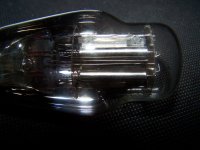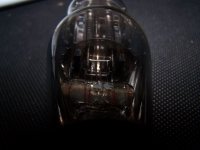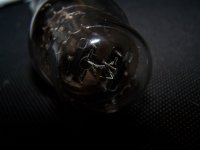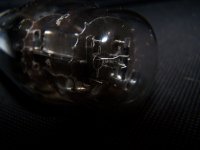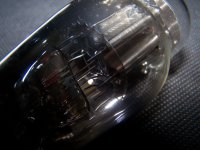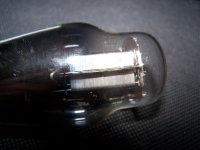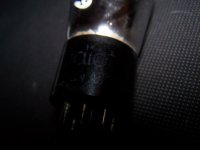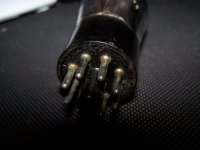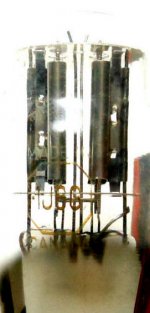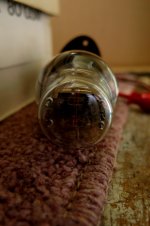Hi , does anyone know this tube ?
its a small shoulder st type ,
it has silver plates ,
its a twin triode ,
its directly heated ,
the plates are 1.5" long by .5" wide
if any has seen one like it I would appreciate the feedback....
thankyou...
its a small shoulder st type ,
it has silver plates ,
its a twin triode ,
its directly heated ,
the plates are 1.5" long by .5" wide
if any has seen one like it I would appreciate the feedback....
thankyou...
Attachments
it wont light up at 2v
I still think its a 6v filament because at 6vdc (4 x D cells) the amount of orange seem accurate …..with just 2x d cells (3vdc) it wont light up....
all the examples i've seen of direct heated cathode are of a brighter nature than straight 6vdc
so its definitely not a 2v filament....

I still think its a 6v filament because at 6vdc (4 x D cells) the amount of orange seem accurate …..with just 2x d cells (3vdc) it wont light up....
all the examples i've seen of direct heated cathode are of a brighter nature than straight 6vdc
so its definitely not a 2v filament....


Very very dimly.
I do not have a 1J6, but this is a PD220 (similar UK double triode 2 volt etc.) at 2.1 volts. I will not go higher.
In day light I cannot see the glow. In a darkened room, just about visible as dull red. The camera actually 'sees' red better than I do, so in the picture it looks brighter than I see it!
Mozz, yes it could possibly be another type, do you have any suggestions?
Alan
I do not have a 1J6, but this is a PD220 (similar UK double triode 2 volt etc.) at 2.1 volts. I will not go higher.
In day light I cannot see the glow. In a darkened room, just about visible as dull red. The camera actually 'sees' red better than I do, so in the picture it looks brighter than I see it!
Mozz, yes it could possibly be another type, do you have any suggestions?
Alan
Attachments
if it quaks it just might be a duck !!
ok , that's about what I get at 3 and a bit volts ….at 2 volts I cant see a glow....maybe its just buggered ! ….I have not had much experience with directly heated tubes ….most examples I saw glowed much brighter , is that example you have , the normal amount of heating for such tubes of the time ?
ok , that's about what I get at 3 and a bit volts ….at 2 volts I cant see a glow....maybe its just buggered ! ….I have not had much experience with directly heated tubes ….most examples I saw glowed much brighter , is that example you have , the normal amount of heating for such tubes of the time ?
I understand.
When you see 211s, 300Bs and even 5R4s all glowing very brightly, it is hard to believe that such a dull glow is enough. It really is.
Cathode emissions is way too broad a subject, but briefly the valve/tube evolved from the incandescent light bulb and consumed as much energy (bright emitters).
To be useful in domestic situations, before mains electricity, chemists found some metals/mixes emitted more electrons and at significantly lower temperatures and resulted in less consumption (dull emitters). Low enough to be used with batteries. Lead acid rechargeable types typically 2, 4 or 6 volts for the filament/heater supply and dry cells for the HT (B+) 90 volts and up.
When mains electricity became prevalent indirectly heated cathodes developed. Fine for home use, but portable cheap to run radios (domestic and military), before transistors, needed to use dry cells for the filament supply too. More chemistry and miniaturisation gave us valves that run off 1.4 volts and a 5 valve set typically draws only 0.3A. Example is the 1T4 you cannot see these glow at all, but they are working!
So, yes - the normal amount of heating for such tubes of the time.
Sorry, too much faff, but hope it helps. Alan
When you see 211s, 300Bs and even 5R4s all glowing very brightly, it is hard to believe that such a dull glow is enough. It really is.
Cathode emissions is way too broad a subject, but briefly the valve/tube evolved from the incandescent light bulb and consumed as much energy (bright emitters).
To be useful in domestic situations, before mains electricity, chemists found some metals/mixes emitted more electrons and at significantly lower temperatures and resulted in less consumption (dull emitters). Low enough to be used with batteries. Lead acid rechargeable types typically 2, 4 or 6 volts for the filament/heater supply and dry cells for the HT (B+) 90 volts and up.
When mains electricity became prevalent indirectly heated cathodes developed. Fine for home use, but portable cheap to run radios (domestic and military), before transistors, needed to use dry cells for the filament supply too. More chemistry and miniaturisation gave us valves that run off 1.4 volts and a 5 valve set typically draws only 0.3A. Example is the 1T4 you cannot see these glow at all, but they are working!
So, yes - the normal amount of heating for such tubes of the time.
Sorry, too much faff, but hope it helps. Alan
- Status
- This old topic is closed. If you want to reopen this topic, contact a moderator using the "Report Post" button.
- Home
- Amplifiers
- Tubes / Valves
- Does anyone know this tube ?
